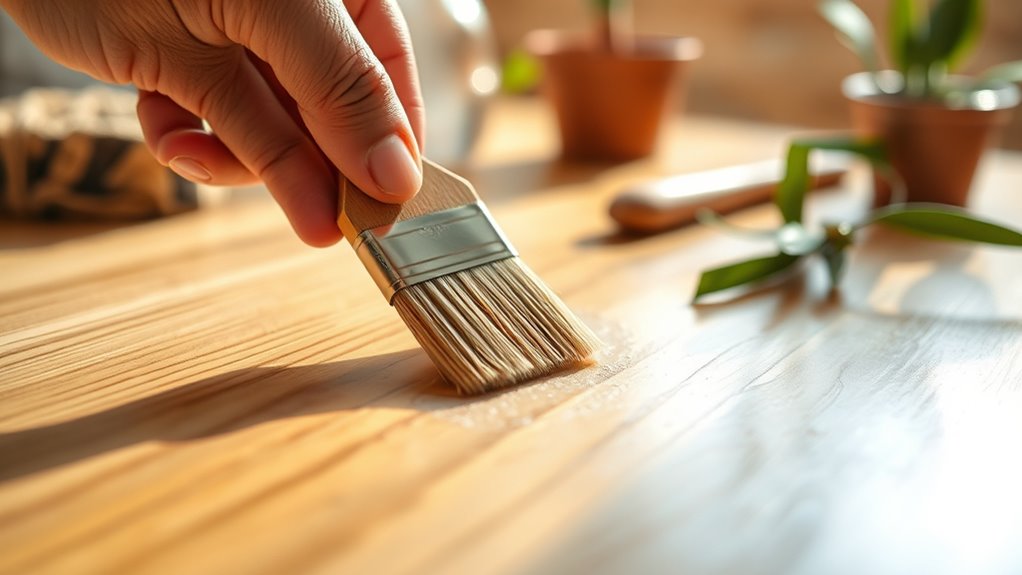Your guide to non-toxic finishes helps you choose low or zero VOC options like natural oils, water-based stains, and plant-based sealants that are safe for your home and the environment. It explains how to prepare surfaces properly, apply these finishes smoothly, and maintain their beauty over time. By following these tips, you create safe, durable projects. Keep exploring to learn detailed steps and expert secrets for achieving flawless, eco-friendly results.
Key Takeaways
- Understand various non-toxic finishes, their benefits, and suitable applications to ensure safety and durability.
- Properly prepare surfaces by cleaning, sanding, and sealing with eco-friendly primers for optimal results.
- Apply finishes using smooth, even techniques, respecting drying times for a flawless, safe coating.
- Choose the right finish type—water-based or oil-based—based on project needs and environmental considerations.
- Maintain non-toxic finishes regularly with gentle cleaning and periodic reapplication to prolong safety and appearance.
Understanding Non-Toxic Finishes: Types and Benefits

Understanding non-toxic finishes is essential if you want to create safer, healthier environments. These finishes typically have low or zero VOC emissions, reducing harmful fumes that can affect indoor air quality. Natural oils, such as tung or linseed oil, are popular non-toxic options because they penetrate deeply, providing a durable, attractive finish without releasing volatile chemicals. Unlike traditional finishes that emit VOCs during application and curing, non-toxic options focus on sustainability and safety. They are often biodegradable and derived from renewable resources, making them environmentally friendly. By choosing natural oils and other non-toxic finishes, you minimize health risks, create a safer space, and contribute to a cleaner planet. These benefits make understanding the different types and their advantages vital for eco-conscious projects. Additionally, selecting finishes that meet safety standards helps ensure the health and well-being of users and the environment.
Selecting the Right Eco-Friendly Finish for Your Project

Choosing the right eco-friendly finish for your project requires evaluating your specific needs, the materials involved, and the desired look and durability. For instance, eco friendly stains can enhance wood’s natural beauty without toxic fumes, while natural sealants provide a protective, non-toxic barrier. To help you decide, consider the table below:
| Finish Type | Best For | Key Benefit |
|---|---|---|
| Eco friendly stains | Enhancing color & grain | Low VOC, natural ingredients |
| Natural sealants | Protection & sealing | Breathable, chemical-free |
| Water-based finishes | Indoor furniture & decor | Easy cleanup, quick drying |
| Oil-based finishes | Exterior wood & high durability | Rich finish, long-lasting |
Preparing Surfaces for a Safe and Durable Finish

Before applying your eco-friendly finish, it’s important to prepare the surface properly to guarantee a safe and long-lasting result. Start by cleaning the surface thoroughly to remove dust, grease, and dirt, which can interfere with adhesion. Sand any rough areas to create a smooth, even surface, using fine-grit sandpaper. If the surface is porous or stained, consider applying eco friendly primers to seal and improve adhesion. Surface preparation techniques also include repairing cracks or holes, filling gaps, and sanding between coats if necessary. Proper prep ensures the finish bonds well and remains durable over time. Using eco friendly primers not only enhances performance but also maintains the safety and sustainability of your project, ensuring a beautiful, lasting finish that’s free from toxins. Additionally, understanding Fokos can provide insights into sustainable and eco-friendly material options.
Step-by-Step Application Techniques for Non-Toxic Coatings

Applying non-toxic finishes correctly guarantees a safe, durable, and beautiful result. Start with proper brush techniques: use smooth, even strokes, and avoid overloading your brush to prevent drips and streaks. Work in manageable sections, maintaining a wet edge to ensure seamless coverage. Pay attention to drying times—wait the recommended period between coats to allow the finish to cure properly. Rushing this process can lead to uneven surfaces or compromised durability. Keep brushes clean and free from excess product, and avoid applying thick layers, which extend drying times and risk imperfections. With patience and precision, your application will yield a flawless, non-toxic finish that enhances your project’s safety and appearance. Additionally, understanding application techniques can significantly improve the longevity and effectiveness of your non-toxic coatings.
Maintaining and Caring for Your Non-Toxic Finishes

How can you guarantee your non-toxic finishes stay beautiful and effective over time? The key is regular maintenance combined with eco friendly cleaning practices. Use gentle, natural cleaning solutions like vinegar and water or castile soap to avoid damaging the finish. Wipe surfaces regularly to prevent dirt build-up, which can dull the appearance. Avoid harsh chemicals or abrasive scrubbers that can strip or scratch the finish. To promote natural preservation, apply a light coat of plant-based oil or wax periodically to maintain luster and protect against moisture. Proper care extends the life of your non-toxic finishes, keeping them safe and beautiful for years to come. Consistent, mindful maintenance is essential for preserving the integrity of eco friendly finishes. Additionally, understanding best heat pump practices can help ensure your heating and cooling systems operate efficiently, reducing the need for repairs and prolonging their lifespan.
Frequently Asked Questions
Are Non-Toxic Finishes Suitable for Outdoor Furniture?
Yes, non-toxic finishes are suitable for outdoor furniture. They offer a safer option with less environmental impact, making them ideal for outdoor use where weather and exposure are concerns. Just remember to follow safety precautions during application, such as wearing gloves and ensuring proper ventilation. These finishes protect your furniture effectively while keeping your outdoor space eco-friendly and safe for family and pets.
Do Non-Toxic Finishes Affect the Color or Appearance of the Project?
Think of non-toxic finishes like a filter on a photo—sometimes they soften colors or add a subtle sheen. They can slightly impact color, making it look richer or more muted, and offer sheen variations from matte to glossy. In my experience, a clear, non-toxic finish enhances natural wood tones without overpowering them, ensuring your project retains its beauty while staying eco-friendly.
How Long Do Non-Toxic Finishes Typically Last Before Reapplication?
Non-toxic finishes usually last between one to five years, depending on their durability lifespan and usage. You’ll need to monitor your project’s wear and tear and reapply when you notice signs of fading, scratching, or dullness. Regular maintenance frequency helps extend their life, so clean and inspect your finish periodically. Ultimately, choosing high-quality, durable non-toxic finishes can reduce reapplication frequency and keep your project looking great longer.
Can Non-Toxic Finishes Be Used on All Types of Wood?
Sure, you can slap non-toxic finishes on all types of wood—because why not? Whether it’s soft pine, dense oak, or exotic teak, these finishes generally play nice with different wood grains and stain compatibility. Just remember, not all finishes are created equal; some might highlight the grain beautifully, while others might obscure it. Always test first to guarantee your eco-friendly choice enhances your wood’s natural beauty.
Are There Any Health Risks During the Application Process?
During the application process, you might face some health risks from chemical exposure or skin irritation, especially if you’re sensitive or don’t use protective gear. To stay safe, wear gloves, masks, and guarantee proper ventilation. Follow manufacturer instructions carefully, and avoid prolonged contact. Taking these precautions minimizes risks, allowing you to enjoy applying non-toxic finishes without worrying about health issues.
Conclusion
So, after all this talk about non-toxic finishes, you might think you’re saving the planet—and maybe you are. But don’t forget, the real trick is making sure you actually use them! It’s ironic how easy it is to pick the perfect eco-friendly finish, yet so many forget to apply it properly. So go ahead, embrace the safer choice—your health and the environment will thank you, even if your project’s not quite as glamorous as you hoped.









